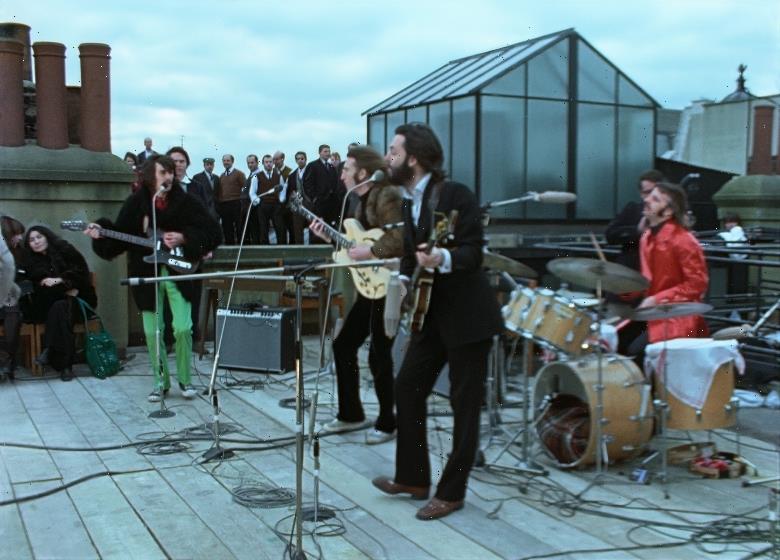

“Get Back” music supervisor Giles Martin sees a wonderful irony to The Beatles’ final live performance: one of the last songs that the band played on the roof of Apple Corps headquarters is also one of the first collaborations between John Lennon and Paul McCartney. “One After 909,” a bluesy American freight-train tribute, epitomized the spirit and energy of The Beatles, who had come full circle after 21 chaotic days of writing, rehearsing, and recording a new set of songs in front of director Lindsay Hogg’s documentary cameras. Those abandoned sessions would later be cobbled together as the band’s swan song, “Let It Be,” but not before the making of their final magnum opus, “Abbey Road.”
The desperate surge of musical unity on the Apple rooftop clinched Peter Jackson’s narrative through line for his miniseries treatment of Hogg’s footage. “Peter and I talked about not making it too glossy,” Martin told IndieWire. “We had the opportunity to be in the room with them or on the rooftop with them. Let’s make it feel like you’re there, in front of them. And when you watch the rooftop, that’s what you feel.”
While mixing the 50th anniversary box set edition of “Let It Be,” Martin — the son of legendary Beatles producer George Martin — detected a different energy from the rooftop performance, of which only “One After 909,” “I’ve Got a Feeling,” and “Dig a Pony” made the original tracklist. “In a funny way, [Jackson’s glimpse through The Beatles looking glass] was trying to make it as real as possible without technology getting in the way,” Martin added. “As soon as you hear the technology, it ages the performances.”


“The Beatles: Get Back”
Apple Corps Ltd.
Tech, though, was the key for Martin in making The Beatles’ performances sound crisp and powerful without compromising their rough spontaneity. Thanks to Jackson’s crack restoration team, they applied machine learning software to extract the music from the rest of the audio, which proved most challenging with the initial “Get Back” rehearsals. Shot on Nagra film at Twickenham Studios, that footage contained mono audio of conversations, crew sounds, and performances; when the production relocated to the band’s own Apple Studio (and, ultimately, its roof), audio was recorded separately on multitrack tape machines.
“It was a question of tone and telling the story and having the right balance,” Martin said. “There was more audio than movie footage, and there are bits that are out of sync with the footage. But we were trying to be as honest as we can. The key thing about the creative process in ‘Get Back’ was you’re trying to capture the beauty and honesty.”
Martin is still working with Jackson’s restoration team on the machine learning and finds it extraordinary. There might even be a place for it in his future remixing of The Beatles catalog (“Rubber Soul” and “Revolver” are particularly complex in terms of separating tracks). “It’s basically about extraction — to teach the machine to find a voice out of a guitar and separate those two elements,” he added. “And that freed things up for us at the end, especially the scale and quality of mixing once you get into a movie theater [for the recent IMAX release of the rooftop performance] when everything is amplified, including the frailties of audio.”


“The Beatles: Get Back”
Apple Corps Ltd.
The biggest revelation was the IMAX screening, which makes the concert sound better than it did in person. “That’s because of the power we can get,” said Martin. “They played hard. The Beatles weren’t a soft band. It’s almost like my job was to convey the reality, the impact, of what it was like playing live and getting close to them. It’s that privileged thing. The whole movie is supposed to be that intimacy.”
And the end result was making sure that viewers weren’t distracted by those frailties “of a crusty old tape” when experiencing The Beatles perform. The performance is elevated by the presence of keyboardist Billy Preston, the “fifth Beatle” (as Lennon considered him) who joined in during the Apple sessions and the rooftop concert. “Preston was energizing,” Martin said. “He’s such a damn good musician that he made them realize that he was someone they needed to perform up to. The thing about Billy is he always played the right part and he reminded them of what they’re good at and what they need to be doing.”
Martin is also appreciative of what Jackson brought to the nearly eight-hour, three-part miniseries. “Peter is an incredible moviemaker and a fan,” he said. “I think what it was [finding] the identity for them, and the fact that we made the right decision in making it this sort of gargantuan [reality TV] thing. I think we live in a world of reality TV anyway. But it’s a much better reality TV having The Beatles than the Kardashians. And Peter’s approach was to suddenly realize how privileged he was to get a tape out and press play and how exciting that is. And I think that’s what he managed to get for people.”
Source: Read Full Article
